Mr Rory Norris is an orthopaedic hand surgeon, specialises in the treatment of hand and wrist conditions. Click on the below tabs to know more about the conditions.
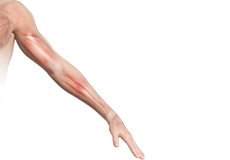

Carpal Tunnel Syndrome
Carpal tunnel syndrome is a common, painful, progressive condition that is caused by compression of the median nerve at the wrist area.
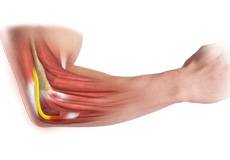
Cubital Tunnel Syndrome / Ulnar Nerve Compression at the Elbow
When the elbow is bent, the ulnar nerve can stretch and catch on the bony bump. When the ulnar nerve is compressed or entrapped, the nerve can tear and become inflamed, leading to cubital tunnel syndrome.
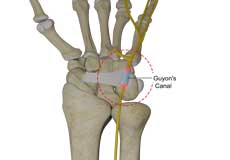
Ulnar Nerve Compression in Guyon's Canal
Ulnar nerve compression in Guyon’s canal is a condition characterized by pain, numbness, weakness, and tingling sensation in the hand.
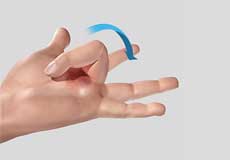
Trigger Finger
Inflammation in the tenosynovium leads to a condition called trigger finger, also known as stenosing tenosynovitis or flexor tendonitis, where one of the fingers or thumb of the hand is caught in a bent position. The affected digit may straighten with a quick snap, like pulling and releasing the trigger on a gun, hence the name trigger finger.
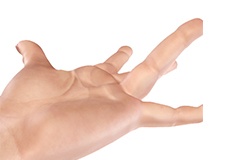
Dupuytren's Contracture
Dupuytren’s contracture is a hand condition where thickening of the underlying fibrous tissues of the palm causes the fingers to bend inward.
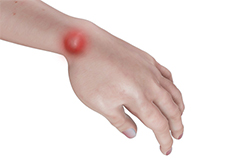
Ganglion Cyst
Ganglion cysts are swellings that most commonly develop along the tendons or joints of wrists or hands.
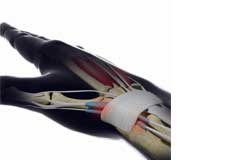
De Quervain's Tendinosis
Inflammation and swelling of the tendon sheaths put pressure on the adjacent nerves and leads to pain and numbness in the thumb side of the wrist.
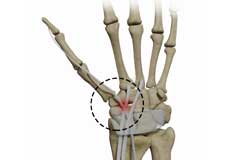
Distal Intersection Syndrome
Distal intersection syndrome also referred to as tenosynovitis of the radial wrist extensors is characterized by the radial wrist and forearm pain..
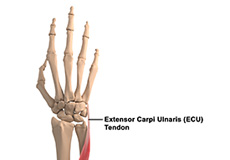
Extensor Carpi Ulnaris (ECU) Tendon Instability
ECU tendon instability can occur when the sheath covering and protecting the ECU tendon at the wrist is injured. This causes the tendon to move abnormally and occupy the wrong space within the sheath.

Ulnar Carpal Impaction
The wrist is a complex joint made up of 8 carpal bones aligned in two rows, with four bones present in each row. The carpal bones are further connected to 5 metacarpal bones that form the palm of the hand.

Kienbock's Disease
Kienbock's disease is a condition in which the lunate, one of the small bones of the wrist loses its blood supply leading to death of the bone.
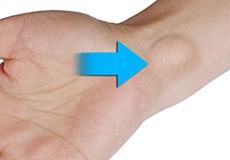
Wrist Tumours
A tumour is a lump or abnormal growth formed due to unregulated cell division. Wrist tumours can occur on or underneath the skin. They are most often benign (non-cancerous).
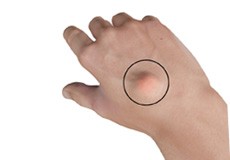
Hand Tumours
Any abnormal lump or bump on the hand is considered a hand tumour. Hand tumours can occur on the skin as a mole or a wart, underneath the skin soft tissue or on the bone. Most hand tumours are benign (non-cancerous); however, they can also rarely be malignant (cancerous).
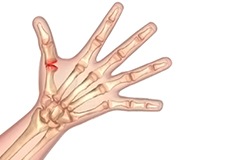
Arthritis of the Hand and Wrist
Arthritis is an inflammatory condition of the joints. There are several types of arthritis and the most common type is osteoarthritis or wear-and-tear arthritis.
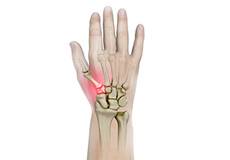
Base of thumb or Trapeziometacarpal (TMC) Arthritis
Trapeziometacarapal (TMC) joint arthritis, also known as carpometacarpal (CMC) joint arthritis or basilar thumb arthritis or rhizarthrosis, is a common form of arthritis that affects the first carpometacarpal (trapeziometacarpal) joint of the thumb. It is an inflammatory condition characterized by gradual wearing away of the cartilaginous surface of the TMC joint and the bones rubbing against each other causing inflammation and pain.
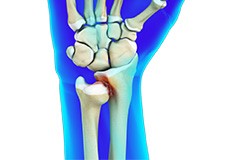
Distal Radioulnar Joint (DRUJ) Arthritis
Distal radioulnar joint (DRUJ) arthritis is an inflammatory condition characterized by gradual wearing away of the cartilaginous surface of the radioulnar joint resulting in significant pain, swelling, stiffness, and interference in the functioning of the wrist and/or arm.
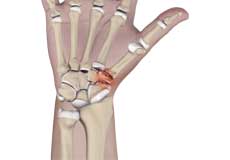
Triscaphoid (STT) joint arthritis
Arthritis is an inflammatory condition of one or more joints in your body. Triscaphoid joint arthritis is the localised pain and inflammation of the shared joint between the 3 carpal bones of your wrist. These bones are called scaphoid, trapezium and trapezoid and are present at the base of your thumb.
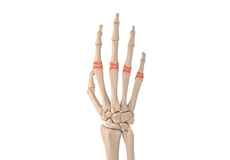
Metacarpophalangeal Joint Arthritis
The bones of the hand are called metacarpals and the bones of the fingers are called phalanges. The metacarpophalangeal joint or MP joint, also known as the first knuckle, is the large joint in the hand where the finger bones meet the hand bones.
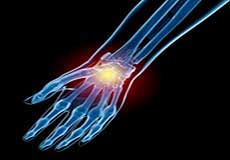
Wrist Injuries
The wrist is a commonly injured joint in the body. Problems include sprains and strains as well as fractures that can occur with lifting and carrying heavy objects, while operating machinery, bracing against a fall, or from sports-related injuries.

Wrist Fracture
The wrist is comprised of two bones in the forearm, the radius and ulna, and eight tiny carpal bones in the palm. The bones meet to form multiple large and small joints. A wrist fracture refers to a break in one or more of these bones.
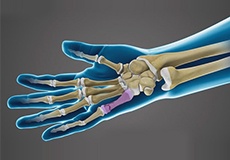
Fractures of the Hand and Fingers
The hand is one of the most flexible and useful parts of our body. Because of overuse in various activities, the hands are more prone to injuries, such as sprains and strains.
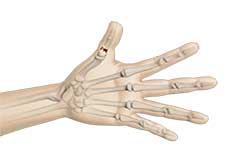
Thumb Fracture
A break or a crack in the bones of the thumb is known as a thumb fracture. Fractures may occur anywhere on the thumb, but a fracture at the base of the thumb, near the wrist, is considered the most serious.
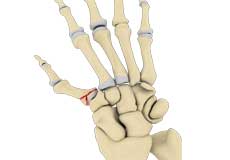
Bennett's Fracture
Bennet’s fracture is a break at the base of the first metacarpal bone (thumb bone) that meets the wrist at the first carpometacarpal (CMC) joint.
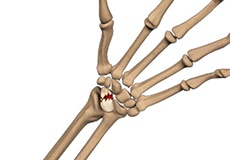
Scaphoid Fracture
The scaphoid bone is a small, boat-shaped bone in the wrist, which, along with 7 other bones, forms the wrist joint. It is present on the thumb side of the wrist, and is at a high risk for fractures. A scaphoid fracture is usually seen in young men aged 20 to 30 years. They can occur at two places: near the thumb or near the forearm.

Boxer's Fracture
A boxer’s fracture is a break in the neck of the fifth metacarpal bone of the hand (below the pinky finger) close to the knuckle. The hand is composed of 3 types of bones: carpal or wrist bones, metacarpals or long hand bones, and phalanges or finger bones. Metacarpals consist of five long bones that connect the carpal with the phalanges. .

Adult Forearm Fractures
The forearm is made up of 2 bones, namely, the radius and ulna. The primary function of your forearm is rotation i.e., the ability to turn your palm up and down. The fracture of the forearm affects the ability to rotate your arm, as well as bend and straighten the wrist and elbow. The breaking of the radius or ulna in the middle of the bone requires a strong force and is most commonly seen in adults. In most of the cases, both bones are broken during a forearm fracture.
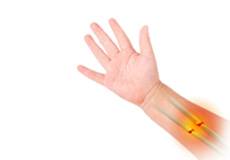
Paediatric Forearm Fracture
The radius (bone on the thumb side) and ulna (bone on the little-finger side) are the two bones of the forearm. Forearm fractures can occur near the wrist, near the elbow or in the middle of the forearm. Apart from this, the bones in children are prone to a unique injury known as a growth plate fracture. The growth plate, which is made of cartilage (flexible tissue) is present at the ends of the bones in children and helps in the determination of length and shape of the mature bone.
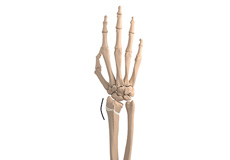
Malunion of a Fracture
Malunion of a fracture is a condition where the fractured ends of a bone heal in a misaligned position resulting in bone deformity. Malunions may occur in any bone fractures in the body often due to trauma.
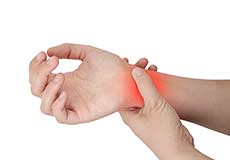
Wrist Sprain
Injuries that involve tearing or stretching of the ligaments of your fingers are termed as sprains. Sprains in the fingers are most often caused from a fall when you extend your arms to reduce the impact of the fall, or from overuse or repetitive activity of the thumb such as with texting.
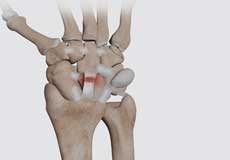
Wrist Ligament Tear and Instability
A ligament is a strong, flexible band of fibrous tissue. The wrist has many ligaments that help to keep the wrist bones in proper position providing stability to the joint. A torn ligament causes the wrist bones to move out of their position, which in turn leads to wrist instability as the sprained (torn) ligament can no longer support the wrist bones.

Distal Radioulnar Joint (DRUJ) Instability
Distal radioulnar joint instability is the abnormal orientation or movement of the radius and ulna bones at the wrist in relation to one another.

Triangular Fibrocartilage Complex Injury (TFCC)
The triangular fibrocartilage complex, or TFCC, is a complex of cartilage and ligaments located near the outer region of the wrist, below the little finger.
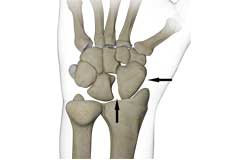
Scapholunate Dissociation
Scapholunate dissociation is the abnormal orientation or movement of the small bones of your wrist: the scaphoid and lunate, in relation to one another.
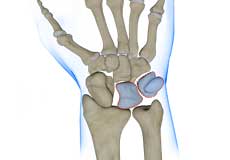
Triquetrolunate Instability
Triquetrolunate instability is the instability that takes place between the triquetrum or medial column and the lunate bones or the central column of the wrist. The triquetrum and the lunate comprise the ulnar side of the proximal carpal row at the wrist. This joint is supported by the lunotriquetral (LT) ligament.
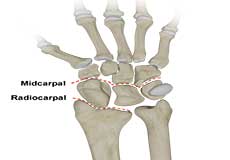
Carpal Instability
Carpal instability is the loss of alignment of the carpal bones and/or radioulnar joint. The wrist is a complex joint that connects the forearm to the hand and allows it to move.
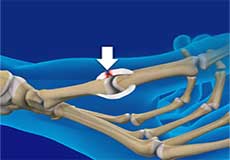
Gamekeeper's Thumb
Gamekeeper's thumb, also known as skier's thumb, is a tear of the ulnar collateral ligament, a band of tissue that supports the joint at the base of the thumb.

Extensor Tendon Injuries
Tendons are bands of tissue connecting muscles to bones. The extensor tendon is a strong, smooth cord that connects finger bones to muscles in the hand.
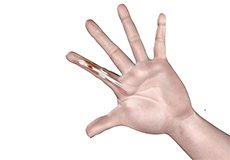
Flexor Tendon Injuries
Deep cuts on the under surface of the wrist, hand or fingers can cut and injure the tendon, and make it unable to bend one or more joints in a finger.

Mallet Finger
The finger joint is a hinge-joint that allows bending and straightening of the fingers. Each finger is composed of 3 phalanges joined by 2 interphalangeal joints (IP joints). The joint near the base of the finger is called the proximal IP joint (PIP joint), and the joint near the tip of the finger is called the distal IP joint (DIP joint).
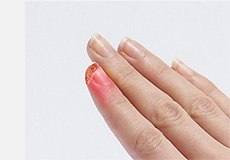
Fingertip Injuries
A fingertip injury is a wound or damage caused to the most distal portion of the finger. It can be a crush, a sharp cut, a tear or a combination of these, and can result in damage to the skin, nail or nailbed, tendon, pulp, bone, and nerve endings. It is one of the most common injuries to the hand and may occur due to accidents at home, work, or play.

Hand Infections
Hand infections, if left untreated or treated improperly, can cause disabilities such as stiffness, contracture, weakness, and loss of tissues
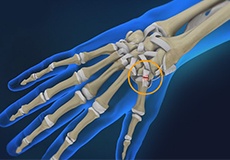
Work Related Hand Injuries
The hand is one of the most flexible and useful parts of our body that assist us in most workplace activities. Hand injuries can range from minor cuts or burns to severe injuries.
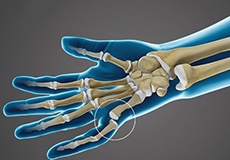
Finger Dislocation
Finger dislocation is a condition in which the bone of your finger has moved away from its normal position.

Finger Joint Dislocation and Volar Plate Injury
Finger dislocation is a condition where the bones of your finger have moved away from its normal anatomical position.
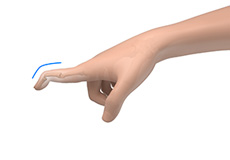
Swan Neck Deformity
The finger joint is a hinge joint that allows the bending and straightening of the fingers. Each finger is composed of 3 phalangeal bones joined by 2 interphalangeal joints (IP joints). The joint near the base of the finger is called the proximal IP joint (PIP joint), and the joint near the tip of the finger is called the distal IP joint (DIP joint).

Boutonniere Deformity
Tendons in your fingers connect the finger bones to finger muscles and help bend and straighten the finger at the joint when the muscles contract.
If you wish to be advised on the most appropriate treatment, please call to schedule an appointment or click to request an appointment online.